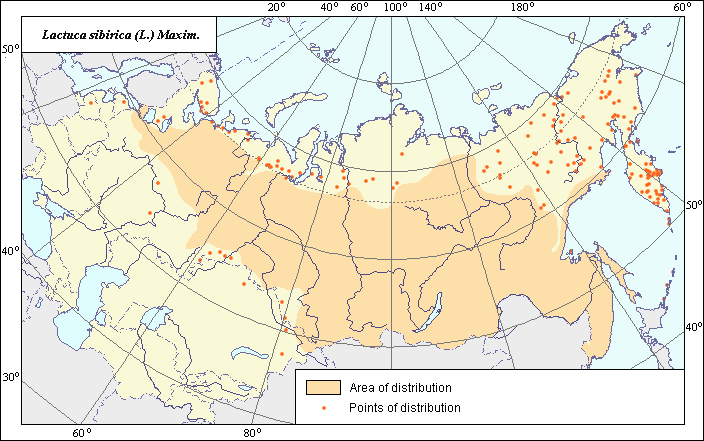Weeds
Area of distribution and weediness of Lactuca sibirica (L.) Maxim.
 Object description Download GIS-layers
Object description Download GIS-layers
Authors:
Specialist-biologist O.E. KravchenkoGIS-specialist I.A. Budrevskaya
Date of creation:
15.03.2004.Scale:
1:20,000,000.Accuracy of map:
Map was created using maps of natural scale 1:8,000,000-1:55,000,000 and published data.Projection:
"Alber's Equal Area Conic for the USSR", 9, 1001, 7, 100, 0, 44, 68, 0, 0.Main content:
Vector map. Main distribution area is shown by polygons, while sporadic distribution is shown by points. Zone of weediness is shown by polygons.Accuracy of classifier:
The distribution area of the species is divided into zones of main distribution, sporadic distribution, and weediness.Mapping procedure:
Zones of distribution and weediness were allocated following an analysis of public cartographical materials and published literature. The Lactuca sibirica distribution map by Hulten & Fries (1986) serves as a model. It was supplemented with data from Kharkevich (1992), Krasnoborov (1997) and Tolmachev (1977). The distribution area was further specified using the references listed below and the materials of the VIR Herbarium of weed plants. Lactuca sibirica grows mainly in forest zones. The northern and southern borders of the distribution area in the European region were drawn in forest zone in accordance with Hulten & Fries (1986). In the northeastern European region, the border was modified in accordance with the data of Tolmachev (1977). In the Far East, the species is distributed throughout the forest and forest-steppe zones (probably because of the man-made ecosystems there) according to Hulten & Fries (1986) and Kharkevich (1992). In Siberia, the species is also distributed throughout the forest zone according Krasnoborov (1997). Only occasionally is the southern border located in the forest-steppe zone. The area of sporadic distribution of Lactuca sibirica is located in forest-tundra at high latitudes in Siberia and the Far East. There is no published data on the weediness of Lactuca sibirica. Hence, we did not allocate a zone of weediness on the map. The unique recent report about the species as a weed belongs to Nikitin (1983). The species can be considered a potential weed only.Sources of data:
Buch T.G., Kachura N.N., Shvydkaya V.D., Andreeva E.R. 1981. Weeds of the Primorskii Territory and their control. Vladivostok: Dalnevostochnoe knizhnoe izdatelstvo, 256 pp. (in Russian).Cherepanov S.K. 1995. Vascular plants of Russia and adjacent states (of the former USSR). Saint-Petersburg: Mir i semja-95. 991 pp. (in Russian).
Desa M.I. 1989. Keys to weed plants of Kirghizia. Frunze: Kirghizstan. 204 pp. (in Russian).
Dorogostaiskaya E.V. 1972. Weed plants of the Far North of the USSR. Leningrad: Nauka. 172 pp. (in Russian).
Fisyunov A.V. 1984. Weeds. Moscow: Kolos. 320 pp. (in Russian).
Goloskokov V.P. (Ed.). 1972. The illustrated keys to plants of Kazakhstan. Alma-Ata: Nauka. Vol. 2. 572 pp. (in Russian).
Hulten E., Fries M. 1986. Atlas of North European Vascular Plants, North of the Tropic of cancer: Konigstein. V. 1-3. 1172 pp.
Keller B.A., Lyubimenko V.N., Maltsev A.I., etc. (Eds.). 1935. Weed plants of the USSR. Moscow - Leningrad: USSR. Vol. 4. 414 pp. (in Russian).
Kharkevith S.S. (Ed.). 1992. Vascular plants of the Soviet Far East. Saint Petersburg: Nauka. Vol. 6. 428 pp. (in Russian).
Krasnoborov I.M. (Ed.). 1984. Keys to plants of Tuva (USSR). Novosibirsk: Nauka. 336 pp. (in Russian).
Krasnoborov I.M. (Ed.). 1997. Flora of Siberia. Novosibirsk: Nauka. Vol. 13. 472 pp. (in Russian).
Krylov P.N., Shishkin V.K., Sergievskaya L.P., Shteinberg E.I., Krasheninnikov I.M. 1949. Flora of Western Siberia. Release 11. Tomsk. pp. 2630-3070 (in Russian).
Maevskii P.F. 1954. Flora of middle belt of the European part of the USSR. Moscow - Leningrad: Selkhosgiz. 912 pp. (in Russian).
Malyshev L.I. (Ed.). 1976. Flora Putorana. Novosibirsk: Nauka. 246 pp. (in Russian).
Nikitin V.V. 1957. Weed vegetation of Turkmenia. Ashkhabad: ?N Turkmen SSR. 581 pp. (in Russian).
Nikitin V.V. 1983. Weed plants of the USSR flora. Leningrad: Nauka. 454 pp. (in Russian).
Orlova N.I. 1993. Abstract of flora of the Vologda Region. In: Trudy SPb ob-va estestvoisp (Works of SPb society of scientists), Vol. 77, rel.3. Saint Petersburg. 262 pp. (in Russian).
Ovesnov S.A. 1997. Synopsis of flora of the Perm Region. Perm: Perm University. 252 pp. (in Russian).
Plotnikov N.A., Levchenko E.K. 1965. Weeds of Western Siberia. Novosibirsk: ZSKI. 190 pp. (in Russian).
Ramenskaya M.L. 1959. Keys to vascular plants of Karelia. Petrozavodsk: Gosudarstvennoe izdatelstvo Karelskoi ASSR. 486 pp. (in Russian).
Shishkin B.K. and Grubov V.I. (Eds.). 1966. Keys to plants of Bashkir ASSR. Moscow - Leningrad: Nauka. 496 pp. (in Russian).
Shishkin I.K. 1936. Weed plants of southern part of the Far East. Khabarovsk. 144 pp. (in Russian).
Syuzev P.V. 1912. Abstract of flora of Ural within the limits of the Perm Region. In: Mat. k poznaniyu fauny i flory Rossiiskoi imperii (Materials to knowledge of flora and fauna of Russian empire). Rel.7. Moscow. 206 pp. (in Russian).
Tolmachev A.I. (Ed.). 1974. Keys to higher plants of Yakutia. Novosibirsk: Nauka. 544 pp. (in Russian).
Tolmachev A.I. (Ed.). 1977. Flora of North-East of the European part of the USSR. Leningrad: Nauka. Vol. 4. 312 pp. (in Russian).
Tsvelev N.N. 2000. Keys to the vascular plants of North-West Russia (Leningrad, Pskov and Novgorod Regions). Saint-Petersburg. 781 pp. (in Russian).
Ulyanova T.N. 1998. Weed plants in flora of Russia and other CIS countries. Saint-Petersburg: VIR. 233 pp. (in Russian).
Voroshilov V.N. 1982. Keys to plants of the Soviet Far East. Moscow: Nauka. 672 pp. (in Russian).

